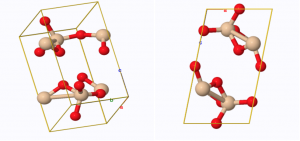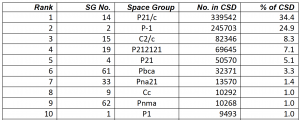If you are the one who has experience of working in a synthetic laboratory, you might come across a single crystal. Have you ever noticed that the inner structure of the crystal is arranged symmetrically?
The symmetry of molecules, atoms, or ions in a single crystal
A single crystal does not grow randomly. It grows in an ordered manner so that a particle can have three-dimensional symmetry to another particle in the crystal. The symmetry between the particles is described as a space group. Easily speaking, the space group is a way to represent the spatial pattern of molecules, atoms, or ions in a single crystal. There are 230 space groups based on group theory, and a well-defined crystal structure shows one of the space groups.
 Figure 1. An example of the space group “P 1 2 1” of a SiO2 crystal. The capital letter P stands for “primitive lattice”, the numbers 1 and 2 represent “1-fold and 2-fold rotation axes”, respectively. The left figure shows SiO2 molecules arranged in a unit cell and the unit cell is described as the Cartesian coordinates a, b, and c. The right figure shows the same unit cell with SiO2 molecules, but b axis is perpendicular to the screen. (Source: http://aflowlib.org)
Figure 1. An example of the space group “P 1 2 1” of a SiO2 crystal. The capital letter P stands for “primitive lattice”, the numbers 1 and 2 represent “1-fold and 2-fold rotation axes”, respectively. The left figure shows SiO2 molecules arranged in a unit cell and the unit cell is described as the Cartesian coordinates a, b, and c. The right figure shows the same unit cell with SiO2 molecules, but b axis is perpendicular to the screen. (Source: http://aflowlib.org)
Statistics of space groups
Molecules, atoms, or ions prefer to be arranged in a certain space group although they have 230 options. The database in Cambridge Crystallographic Data Centre (CCDC) contains more than one million crystal structures, and the number increases every day. The data centre reported that 986,061 structures show fully defined space groups. Interestingly, 34.4 % and 24.9 % of the structures have the space group “P 21/c” and “P -1”, respectively (Table 1). The key point is that more than 50 % of crystals, which you may come across in a laboratory, have particles arranged in either the space group P 21/c or P -1.
 Table 1. Top 10 frequently occurring space groups. SG and CSD stand for space group and Cambridge structural database, respectively. (Source: CCDC, published in January 2019)
Table 1. Top 10 frequently occurring space groups. SG and CSD stand for space group and Cambridge structural database, respectively. (Source: CCDC, published in January 2019)
– Young Cho
